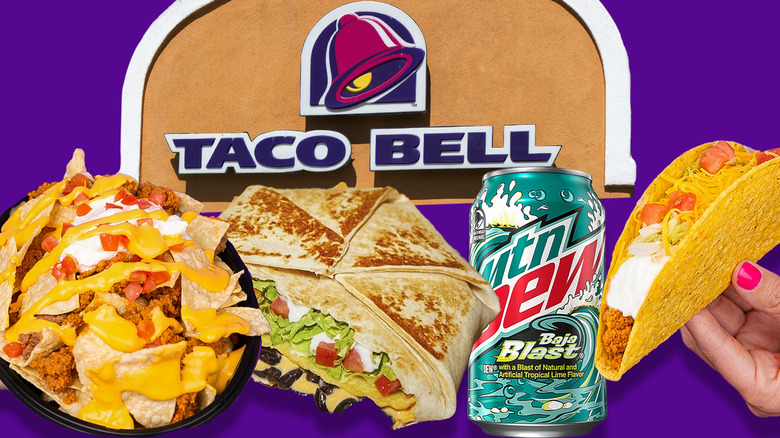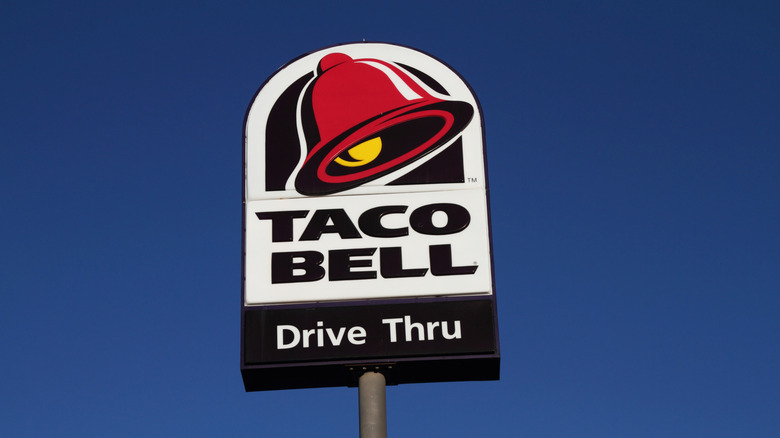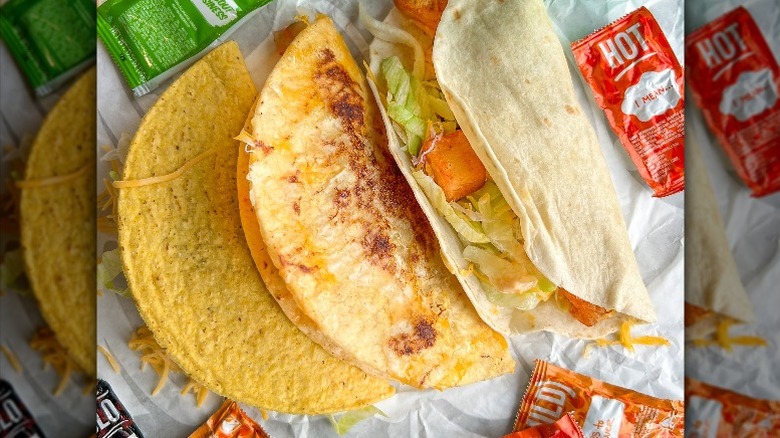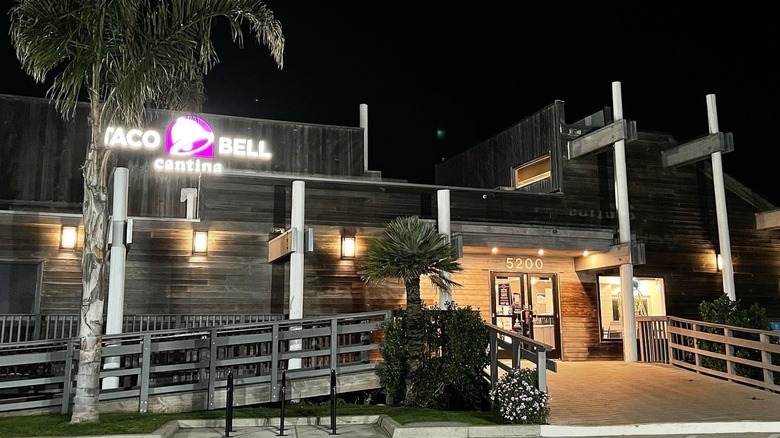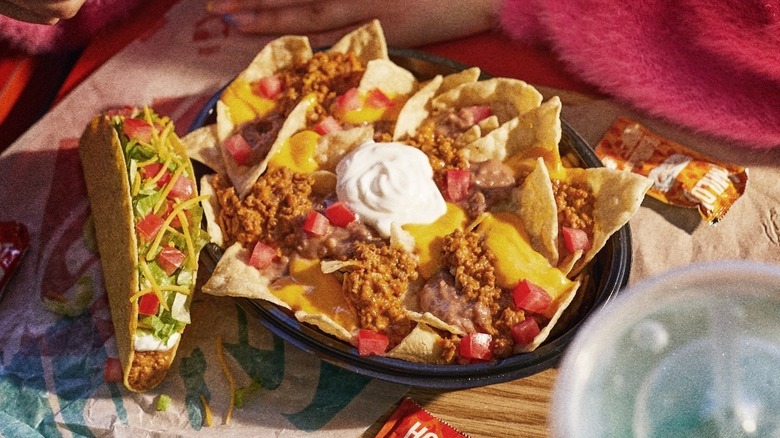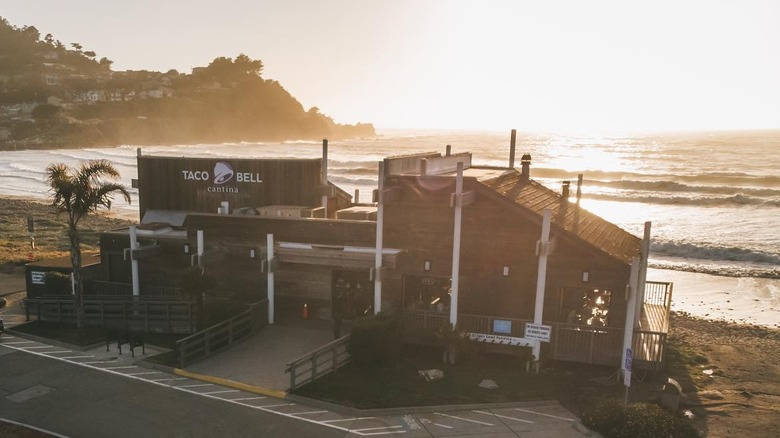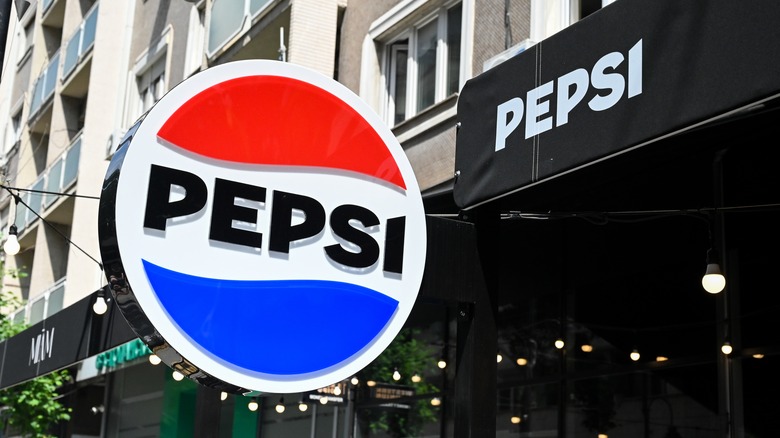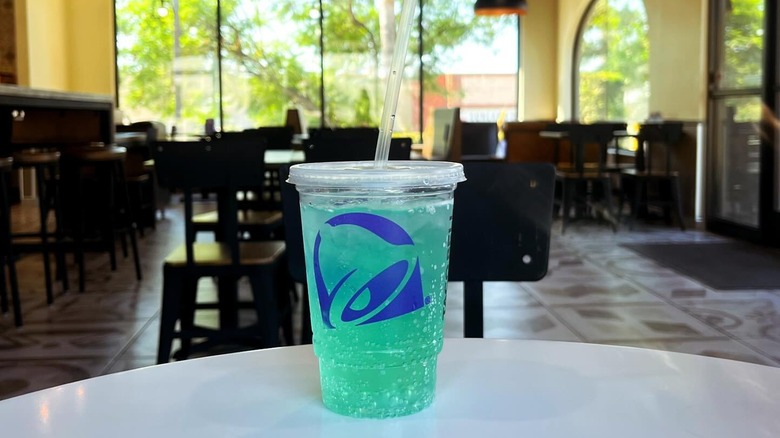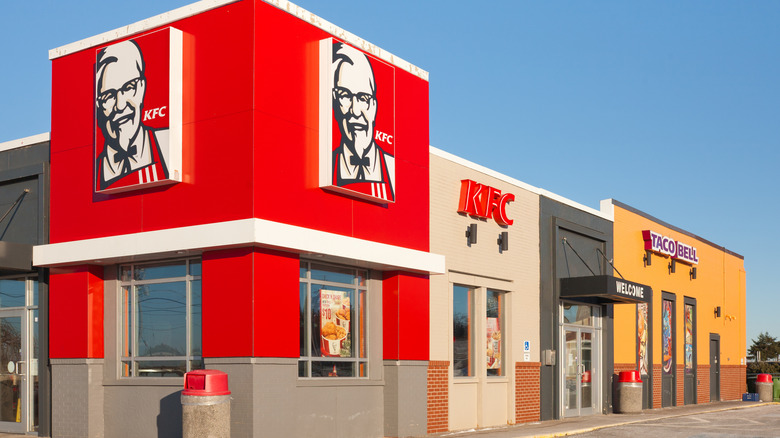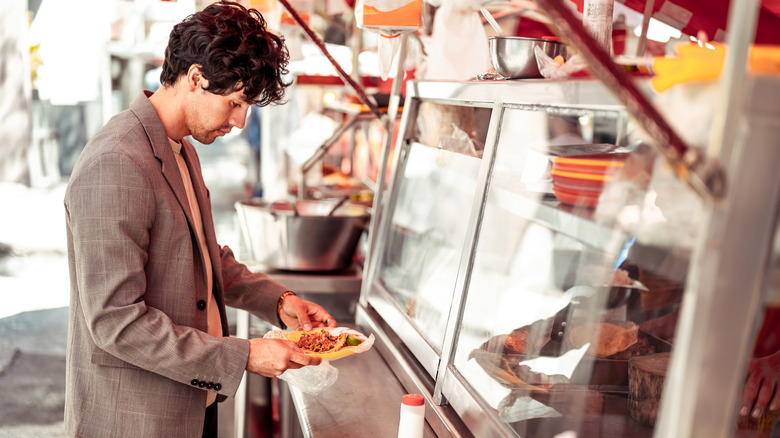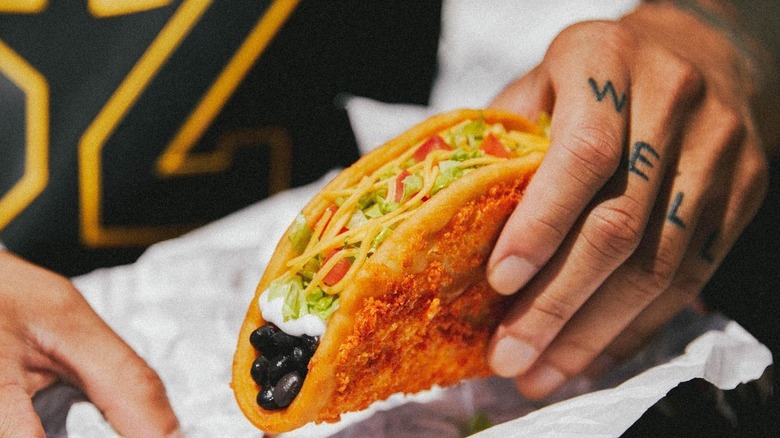14 Secrets You Didn't Know About Taco Bell
It's safe to say that Taco Bell has earned its place as a fast-food giant, known for satisfying cravings and inspiring a dedicated fan base worldwide, sometimes even during the wee hours of the night. While many know the chain for menu staples like the Crunchwrap Supreme or the Cheesy Gordita Crunch, Taco Bell has a lot more going on than meets the eye. Beyond its menu, the brand's history includes quirky stories, surprising innovations, and a few lesser-known facts that paint a fuller picture of this wildly popular chain.
From its beginnings as a small taco stand to its rapid expansion, Taco Bell has grown with a mix of experimentation and a distinct approach to Mexican-inspired flavors. Whether introducing unique partnerships or launching unexpected menu items, it has navigated the fast-food industry with its own flavor and flair. Even for seasoned fans, there are plenty of curious details and fun backstories that don't always make it into the spotlight.
So, if you're interested in the story behind the tacos, let's dive into some surprising facts and unusual twists that add a little more depth to Taco Bell's place in the fast-food world.
The name Taco Bell comes directly from its founder
It might seem like Taco Bell's name was just a catchy branding decision, but it's actually pretty straightforward — it's named after Glen Bell, the man who started it all. Bell first entered the food industry back in 1948 with a humble hamburger stand called Bell's Hamburgers, located near San Bernardino, California. He initially focused on traditional American fast food, but being so close to Mexico must have sparked his interest in Mexican-inspired cuisine.
By 1954, Bell launched a taco stand called Taco Tia, where he introduced his take on tacos to the public. This new venture marked the beginning of his journey toward creating what would eventually become Taco Bell. After years of refining his approach, Bell opened the first official Taco Bell location in Downey, California, in 1962. The restaurant's simple menu and fast, affordable offerings quickly made it a hit, growing to proportions he likely had not expected.
What started with Bell's small taco stand has since grown into an international chain with over 8,000 locations in more than 30 countries. Now, a man's plain old last name has become synonymous with fast-food tacos around the world.
When it first opened, customers had no idea how to eat a taco
When Taco Bell first opened in California, tacos weren't yet a staple on the average American dinner table. In fact, they were so unfamiliar to early customers that many didn't even know how to eat them. The taco's shape and texture were confusing to people used to burgers and sandwiches, so much so that customers would mispronounce it as "tay-koh" and try to eat it sideways as if it were a sandwich. This was an unexpected hurdle for Taco Bell founder Glen Bell, who realized he'd have to go beyond just serving tacos — he needed to teach people how to enjoy them.
To tackle this problem, Taco Bell's first Chief Operating Officer, John Gorman, came up with a simple but effective solution: staff members began showing customers the correct way to hold and eat a taco, ensuring they'd be able to fully appreciate the unique flavor and texture. These early efforts in customer education were no doubt crucial in helping tacos become an American fast-food favorite.
Over time, Taco Bell introduced other menu items, like burritos and nachos, that further helped to familiarize Americans with Mexican-inspired food. But those early employees, patiently teaching people to handle and savor a taco, played a dutiful role in popularizing this iconic item across the country. Today, it might seem second nature to reach for a taco — but for those first customers, learning to eat one was an adventure in itself.
Some locations offer alcoholic beverages
For those seeking a slightly more mature experience at Taco Bell, there are options beyond fountain drinks at select locations. Known as Taco Bell Cantinas, these special spots serve alcoholic beverages alongside their classic fast-food menu. Customers can choose from several options, including spiked versions of popular frozen drinks like the Mountain Dew Baja Blast or the Twisted Blue Raspberry Freeze. The Cantina Margarita is another popular choice, offering a tangy twist on a classic Mexican cocktail.
The concept of Taco Bell Cantina locations emerged as a way to offer a unique, elevated experience compared to the typical Taco Bell. The ambiance in Cantina locations often goes beyond fast food, with modern decor and a lively atmosphere designed to attract a crowd that enjoys the fusion of cocktails and quick, casual dining. You'll find Cantina restaurants scattered across various cities around the globe, each bringing a unique charm while still embodying the fun, fast-food Taco Bell vibe we all know and love.
Beyond being just a novelty, Taco Bell's Cantina concept illustrates its effort to adapt to evolving dining trends, where fast food and social drinking intersect. In other words, Taco Bell clearly understands that sometimes, pairing a crunchy taco with a cocktail is exactly what customers are looking for.
The chain was among the first to give women managerial roles
In the 1960s, women in management were a rarity in most industries, including fast food. Taco Bell, however, became one of the early exceptions. John Gorman, the company's first Chief Operating Officer, found that the limited pool of male managers didn't meet the growing demand for capable leadership in the chain's restaurants. In response, he began hiring women for managerial positions, which was a notable shift away from standard industry practice at the time.
This decision to expand the hiring pool by including women not only addressed the company's staffing needs but also gradually influenced the larger fast-food industry, helping pave the way for more diverse leadership across the field. Over time, Taco Bell's early openness to female managers added to a growing movement in the fast-food sector and beyond, which recognized that managerial talent could come from all backgrounds.
Surprisingly, its beef is actually all beef
Taco Bell has faced its fair share of rumors about its beef, but the truth is a lot less mysterious than the myths suggest. The fast-food chain's seasoned beef has long been the subject of speculation, with some customers wondering if Taco Bell's beef actually contains very much real beef at all. In 2011, a lawsuit challenged Taco Bell, referring to its beef as some kind of mystery meat.
Instead of staying silent, Taco Bell took a bold approach to set the record straight. It ran a full-page ad in major newspapers with the headline, "Thank you for suing us," and printed its beef's true ingredients: 88% beef and 12% secret recipe. It then went on to share that so-called secret recipe, which included water, Mexican spices, a variety of typical seasonings, cocoa powder, oats, caramelized sugar, yeast, and citric acid.
These days, Taco Bell's website now makes it clear that its seasoned beef is made from 100% USDA premium beef, explaining that it is then prepared with its signature seven-spice blend and packaged with water. The chain even joined the U.S. Roundtable for Sustainable Beef to ensure customers that its beef is sustainably sourced. For a fast-food brand with a playful image, Taco Bell sure takes its ingredient quality more seriously than most of us might have imagined.
One Bay Area location boasts a breathtaking view of the beach
If you're looking to enjoy Taco Bell with a view, head to Pacifica, California. This Taco Bell location, nestled right on the edge of the Pacific Ocean, offers a unique fast-food experience with stunning ocean views. Known by some as America's most beautiful Taco Bell, this location in the San Francisco Bay Area is more than just a quick stop for tacos. It's become a recognized destination for both locals and tourists alike. Here, you can enjoy your meal on a beachfront patio while watching the waves and, if you're lucky, even catch a glimpse of migrating whales.
Beyond the beautiful view, this particular Taco Bell is also a Cantina location, meaning patrons can pair their Taco Bell meal with a refreshing alcoholic beverage. All in all, it's clear this location is not all about the food. The experience is another factor that brings in lots of guests, offering a strangely perfect spot to relax and enjoy the beauty of the California coastline.
Pepsi used to own Taco Bell
Taco Bell first opened in 1962 in Downey, California, and quickly gained a devoted following with its innovative approach to Mexican-inspired fast food. By 1964, there were already 100 locations, and the chain's growth showed no signs of slowing down. By 1978, even PepsiCo saw Taco Bell's potential and decided to acquire all 868 Taco Bell locations from founder Glen Bell in a landmark $125 million deal.
Pepsi's ownership marked a turning point for Taco Bell, providing the resources needed to take it from a regional chain to a national fast-food powerhouse. With Pepsi's backing, Taco Bell launched large-scale marketing efforts and expanded its reach across the U.S., setting the stage for it to become a fixture in American fast food. This acquisition truly laid the foundation for Taco Bell to grow into the global brand it is today, with a quirky identity and a loyal customer base.
Mountain Dew's Baja Blast flavor only exists thanks to Taco Bell
In 2004, Taco Bell and Mountain Dew teamed up to create a one-of-a-kind drink exclusively for Taco Bell customers: Baja Blast. The partnership made sense, as both brands were owned by Pepsi at the time. It didn't take long for Baja Blast to become a cult classic, offering a tropical lime flavor that complemented Taco Bell's menu perfectly.
The drink's popularity led to special limited-time retail releases starting in 2014, marking its 10th anniversary. Customers could now enjoy Baja Blast outside the restaurant, but only during certain periods. By its 20th anniversary in 2024, Baja Blast had become such a beloved flavor that Pepsi made it a true addition to the Mountain Dew lineup, available year-round in stores.
What started as a fast-food exclusive has now evolved into a widely popular soda flavor, thanks to its strong connection with Taco Bell and loyal fans.
KFC and Pizza Hut are owned by the same company as Taco Bell
Yum! Brands is the parent company behind several popular fast-food chains you're likely familiar with, including Taco Bell, KFC, and Pizza Hut. While each of these brands is famous for its unique menu — Taco Bell for its Mexican-inspired options, KFC for fried chicken, and Pizza Hut for pizza — they all operate under the same corporate umbrella. And if you're in the mood for a classic American burger, Yum! Brands also owns Habit Burger Grill, which specializes in burgers and other American favorites. Together, Yum! Brands' diverse restaurants offer something for almost every craving.
Yum! Brands has a history tied to PepsiCo, starting in 1977 when Pepsi ventured into the restaurant business by acquiring Pizza Hut. Taco Bell followed in 1978, and KFC joined the fold in 1986. In 1997, PepsiCo spun off its restaurant division into a separate company called Tricon Global Restaurants, which became the parent company of Taco Bell, KFC, and Pizza Hut. Then, in 2002, Tricon rebranded itself as Yum! Brands, consolidating its focus on these major fast-food chains under one name. With all the brands combined, there are more than 59,000 restaurants across the globe operated mostly by its 1,500 franchisees. This makes it the largest restaurant company worldwide.
There are no Taco Bell locations in Mexico
Tacos originated in Mexico, so that might make you think that Taco Bell would be a popular chain there. Think again. The chain has tried over the years to open locations in Mexico, but with no success. To this day, there is not one Taco Bell location south of the border. One of the main reasons for Taco Bell's failure in Mexico seems to be that customers simply aren't interested in the Americanized version of their beloved tacos.
Another reason could be that tacos are an essential part of Mexican cuisine, and they're widely available at countless street stands and restaurants throughout the country. For Mexicans, the idea of a fast-food taco is both unfamiliar and unnecessary, especially when it's easy to find freshly made, authentic tacos for a fraction of the price. On top of that, Taco Bell's attempt to introduce menu items with names that never resonated with local tastes or customs led to further confusion. While Taco Bell continues to thrive in many other parts of the world, it doesn't seem anywhere close to setting up shop in the home country of the taco.
Taco Bell offers educational scholarships for youth
Since 1992, the Taco Bell Foundation has offered educational support and career-readiness resources for underserved young people. Through its Live Más Scholarship, the foundation provides financial assistance to students pursuing a variety of paths, including academic, creative, and technical fields. The scholarship is unique in that it's available not only for traditional degree programs but also for creative pursuits and personal projects.
The foundation's efforts go beyond scholarships alone. It has raised hundreds of millions of dollars to date, which have also been channeled to nonprofit organizations working on education access and skill-building programs. According to the foundation, these funds have reached millions of students, with resources geared toward helping them navigate career options and educational goals. By supporting these programs, the foundation aims to make it a little easier for young people to gain relevant experience and actually pursue the futures they've envisioned.
Just as the name of the scholarship suggests, the Taco Bell Foundation really is helping young people "live más" by giving them the resources they need to fuel their passions and achieve their goals.
You can get married at Taco Bell
At the Taco Bell Cantina in Las Vegas, you'll find more than just food on the menu. You'll also find another surprise: weddings. The restaurant offers a special "wedding package" that lets couples say "I do" in a unique Taco Bell-themed ceremony, complete with Taco Bell décor and a sauce packet bouquet. The wedding package includes a ceremony inside the restaurant's private chapel, Taco Bell-branded wedding essentials, a party pack of Taco Bell food, and a space to celebrate with 25 of your loved ones, if you like.
Couples have been exchanging vows here since the option first launched in 2017, and it's become a quirky, popular choice for Taco Bell lovers looking for a light and fun way to get married. Because of its popularity, it's a good idea to book ahead. Interestingly, you can also request to get married at other Taco Bell locations outside of Vegas, though you'll have to organize it with a local manager.
Taco Bell is working to reduce its environmental impact
In 2020, Taco Bell announced a major sustainability goal: by 2025, all of its consumer-facing packaging worldwide would be recyclable, reusable, or compostable. The company also committed to eliminating harmful substances like BPA, PFAS, and Phthalates from its packaging. This move is part of Taco Bell's broader strategy to reduce its environmental footprint, responding to growing concerns about plastic waste in the fast food industry.
In addition to making its packaging more sustainable, Taco Bell has partnered with global recycling company TerraCycle to help repurpose hard-to-recycle materials. This program focuses on diverting waste from landfills by finding creative ways to repurpose packaging and materials that would otherwise be difficult to recycle through traditional means. These efforts are hopefully just the beginning of an upward trend in the fast-food industry, as brands increasingly focus on becoming more eco-friendly and sustainable for the sake of the planet.
Its vegetarian menu has an official certification
Taco Bell's vegetarian menu offers an impressive variety of plant-based options for a fast-food chain. But that's not the only reason it stands out — it's also officially certified by the American Vegetarian Association (AVA). Now you might wonder, does this really matter to fast-food customers? The truth is, this certification ensures that every menu item is free from animal-derived ingredients, giving vegetarians confidence in their choices and probably making them more likely to pick Taco Bell over its competitors. So, yes, it does matter.
The vegetarian menu includes everything from customizable burritos and tacos to creative options like the Veggie Power Bowl. Many dishes can also be easily made vegan, adding an extra layer of flexibility for plant-based eaters. Taco Bell has made a clear effort to expand its meatless menu, responding to the growing demand for plant-based choices that are delicious as well. These offerings go beyond the typical vegetarian fare found at most fast-food chains, which often feel like an afterthought rather than a carefully crafted option.
